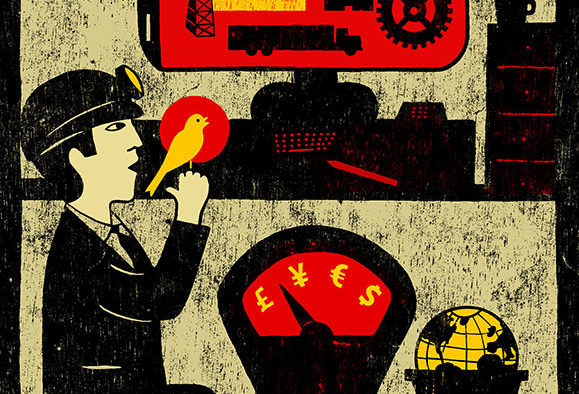How are the Small Countries Doing?

 Why and how small advanced economies – the canaries in the coal mine – are signalling the emergence of new fault lines in the global economy
Why and how small advanced economies – the canaries in the coal mine – are signalling the emergence of new fault lines in the global economy
The norms, ideas and institutions that have provided the foundation for the global economic system for decades are under great pressure. Consider the protectionist rhetoric in the US presidential campaign, the growing challenges facing European integration – most obviously in the Brexit vote – and the increasingly explicit role of geopolitics in shaping international commerce, including trade agreements such as the Trans-Pacific Partnership (TPP).
All of this may not yet amount to a reversal of globalization, but it is a marked step away from the hyper-globalization of the past 25 years – a period of very strong growth in cross-border trade and investment. To better understand the emerging fault lines in globalization and the potential for disruptive change, it is instructive to look at the experience of small advanced economies – that is, countries like New Zealand, Singapore, the Nordics, the Baltic states, Switzerland, the Netherlands and Israel. As I noted in the Spring/Summer 2013 issue of GB, such small advanced economies have long served as a good barometer of the health and functioning of the global economic system. Because they are acutely exposed to the global economy, global dynamics show up cleanly and quickly in these countries.
To be sure, small advanced economies have prospered in an era of intense, rules-based globalization. However, recent small-country experience suggests a much more challenging political economy of globalization. Small countries are reflecting a global context that has much in common with the 1970s – a period of slowing, volatile growth, domestic political unrest, and a fluid international economic system. For the most part, small advanced economies are responding quickly and creatively to this emerging environment. And yet the scale and nature of the new fault lines in the global economic system, as well as the potential for rupture, commend themselves to an aggressive watching brief.
Small advanced economies are pointing to the emergence of three fault lines in the global economy: increased domestic economic and political pressures from globalization; challenges to existing models of regional economic integration; and, finally, a more explicit interaction between international economics and politics.
Small advanced economies are pointing to the emergence of three fault lines in the global economy: increased domestic economic and political pressures from globalization; challenges to existing models of regional economic integration; and, finally, a more explicit interaction between international economics and politics.
Domestic Pressures. Small advanced economies benefited enormously from the intense processes of globalization over the past 25 years. The high, growing exports and outward investment shares, as well as the successful activities of small-country multinational companies, have supported strong economic performance by small countries. The strategic posture of most small countries is deeply outwardly oriented, aimed at building positions of competitive advantage through high-quality policy settings and investments in innovation and public goods like education and strong social insurance systems. Relative to larger economies, small countries have managed globalization well. This policy approach has helped to sustain solid public support for openness and globalization.
Nevertheless, the experience of globalization in small countries is changing in ways that are weakening public support for openness and requiring different policy approaches. For example, strong migration rates are placing pressure on labour markets and infrastructure in several small countries. Some governments are responding with increasingly tough stances, with referenda in Switzerland on restricting migration, and Singapore imposing tighter controls on migration. In Europe – from Austria to the Nordics – this trend has been exacerbated by large refugee inflows from the Greater Middle East.
Relative to larger economies, small countries have managed globalization well. This policy approach has helped to sustain solid public support for openness and globalization.
Similarly, ultra-loose monetary policy in the US and the Eurozone is having disruptive spillover effects on small economies, leading to strongly appreciating exchange rates (Switzerland and New Zealand), rapidly appreciating property prices (the Nordics and New Zealand), and low or negative inflation rates (Singapore and Sweden). This is creating significant complications for small-country policy-makers as they try to deliver strong growth rates, low (targeted) inflation, and general financial stability. From Switzerland to Israel, then, and from Singapore to New Zealand, small countries are intervening more actively in foreign exchange markets and establishing restrictions on foreign ownership.
There are also indications of increased small-country resistance to international liberalization in the service sectors. In New Zealand, for example, there has been a surprisingly high level of protest against specific aspects of the TPP deal – such as the investor-state dispute settlement mechanism – as well as against liberalization in a general sense. Bref, the instinctive small-country support for globalization is weakening as global engagement presents increasingly material challenges and risks to growth, employment and asset prices. That these behaviours are observed consistently across quintessentially open small economies that have profited substantially from globalization suggests structural changes in attitudes toward globalization. This is, in other words, more than concern about globalization from the usual suspects or discontents.
Small-country governments are responding with a more managed approach that allows them to exercise more policy discretion in areas that are economically or politically important. Of course, this is a tough balancing act. And in larger countries, from France to the UK and the US, there is frequently a less calibrated response, with greater protectionist sentiment, as governments respond to global forces that are reaching further inside national economies.
Regional Integration Challenges. An important driver of globalization over the past few decades has been regional integration: 70 percent of European trade is intraregional in nature, as is 50 percent of Asian and 60 percent of North American trade. Formal regional arrangements in Europe, Asia and the Americas, such as the EU, ASEAN and NAFTA, together with the connective tissue of regional supply chains and infrastructure networks, have shown that globalization remains heavily regionally organized.
Small countries have long placed regional economic integration at the centre of their economic strategies. In Europe, of course, the Benelux countries were the founding nations of the six-member European Economic Community. Subsequently, other small European countries became very active participants in the EU. For its part, ASEAN is a central element of Singapore’s external strategy. Indeed, only two small countries have developed into advanced economies without deep integration into their respective regional economies: New Zealand (for geographic reasons), and Israel (for geopolitical reasons). But for the overwhelming majority of small countries, regional economic integration is a strategic imperative.
In this context, it is striking that small countries have been at the forefront of resisting more intensive European regional engagement. Northern European economies like the Netherlands have long been signalling frustration with Brussels on issues such as the patchy application of economic and fiscal rules, as well as the bailouts of countries like Greece. Other recent examples include Iceland suspending EU membership negotiations, the latest ‘No’ vote in a Danish referendum in 2015 on removing that country’s opt-out from several EU home and justice policy matters, the 2014 Swiss referendum vote to impose limits on immigration, and Finland’s foreign minister suggesting in December of last year that Euro membership had been a mistake for Finland. The Austrian presidential election result in May of this year – now to be rerun this fall – was another signal of increased nationalism in a small European country.
Tighter regional integration is being challenged by a desire for greater domestic policy autonomy to respond to issues in ways that reflect the local context, as well as by associated concerns about the political legitimacy of decision-making at the centre of very large economic blocs. There is little small-economy appetite for formal European integration – that is, into an economic or fiscal union, or into some deeper federal framework. Instead, there is a consistent view in small northern European countries on EU reform that emphasizes a looser model of integration based on the primacy of nation-states, clear rules, and a liberal approach.
Small economies are not decoupling from their respective regions in response to these emerging political pressures, but are instead trying to alter the balance between domestic and regional-level policy autonomy. By contrast, larger economies are more disposed to push for a more centralized model with institutions such as an economic and fiscal union, or to completely separate in a quest for national sovereignty (as reflected in the UK’s Brexit vote). Small economies, in turn, see both of the latter approaches as containing fundamental dangers.
Although post-Brexit opinion polls in several small countries confirm ongoing strong support for EU membership, the small-economy experience clearly indicates that there are fault lines emerging in regional integration. If this pressure is not well managed by the EU member states, both individually and collectively, it could quickly lead to institutional unravelling that weakens the global economy.
Geopolitics. The liberal, rules-based global economic system that has prevailed over the past several decades has helped to separate international commerce from the projection of political or strategic power. However, the demarcation between international economics and politics is arguably becoming less clear. The weakening of multilateral institutions means that trade liberalization increasingly occurs on a regional or bilateral basis, which elevates political considerations. And the transition to a multipolar world, in which major economic players like the US and China have differences in their strategic preferences, exposes the functioning of the global economy to geopolitical considerations and calculations: consider, in Asia, overlapping trade deals like the TPP and ASEAN’s Regional Comprehensive Economic Partnership, or new development institutions like the Asian Infrastructure Investment Bank (AIIB).
To be sure, these developments create specific exposures for small advanced economies. This is most apparent in the negotiation of trade agreements, where the ability of small countries to secure agreements is constrained by their limited domestic market size. More importantly, of course, these negotiations also necessarily expose small advanced economies to the strategic predilections and caprices of larger countries. For example, New Zealand signed a free-trade agreement with China in 2008, partly on the back of Wellington’s early willingness to grant China ‘market economy’ status at the WTO. However, New Zealand has not secured a bilateral deal with the US, reflecting the challenged relationship with Washington since Wellington took New Zealand out of the ANZUS alliance in the 1980s.
Small countries can also be squeezed by larger countries. I have written in GB about the risk exposures inherent in the asymmetric relationship between small and large countries such as New Zealand and China (see my In Situ article in the Fall/Winter 2015 issue of GB). This is true in many other bilateral relationships – for example, between China and several of the ASEAN countries. Small advanced economies increasingly have to deliberately balance economic and broader strategic interests, which invariably imposes economic costs.
Moreover, small advanced economies are often exposed to the spillover effects of strategic economic competition between large countries. Increasingly, international economic engagement by large countries, through vectors like the TPP and the Transatlantic Trade and Investment Partnership (TTIP), is framed in geostrategic terms. For instance, a primary stated source of value of the TPP for Washington is to set the rules of the game on a basis that is acceptable to the US, and to represent the economic arm of the pivot to Asia. And yet many small-economy members of the TPP value the agreement principally for economic reasons, and do not wish it to become part of a binary strategic choice between Washington and China.
Small countries are also affected by the apparently increased willingness or disposition of large countries to take unilateral action – a trend that poses significant long-term risks to an open global economy. For example, the US tendency toward extra-territorial jurisdiction on tax and financial sector issues has impacted small economies like Switzerland. And the increasing noise in the US in respect of imposing sanctions on ‘currency manipulators’ or countries with sustained current account surpluses is another example of the potential unilateral use of power in the global economic system. For its part, Russia’s annexation of Crimea sent clear signals to smaller NATO border countries like Estonia, Latvia and Lithuania, to neutral small countries like Sweden and Finland, and indeed to small-country members of the Eurasian Economic Union like Armenia.
Better than most, small advanced economies appreciate the impact that geopolitical frictions are already having on globalization, and indeed how marked a change this is from the past few decades. Small countries in Asia, such as New Zealand and Singapore, and in Europe, such as Finland and the Netherlands, have first-hand experience of these emerging challenges. They are responding through a combination of strategic balancing and hedging, even if major exposures remain.
A careful release of pressure through calibrated policy may lead the global economy to a better, more sustainable position. Alternatively, growing pressure could cause fault lines to rupture – causing significant damage.
Small advanced economies around the world – the canaries in the mine, as it were – are reflecting the emergence of new fault lines in the global economy. The impact of the pressure from moving tectonic plates depends significantly on how it is managed by national government policy-makers. A careful release of pressure through calibrated policy may lead the global economy to a better, more sustainable position. Alternatively, growing pressure could cause fault lines to rupture – causing significant damage.
For the most part, small advanced economies are remaining open, responding to domestic economic and political challenges even as they manage international economic integration. This is reminiscent of the ‘embedded liberalism’ aspiration of the design of the original Bretton Woods system, in which an open, liberal international economic system was designed to be consistent with a measure of domestic political autonomy. For at least a few decades after 1945, this system underpinned rapid growth in cross-border trade and investment while retaining reasonable political legitimacy.
Positively framed, this may suggest that the basic structure of the global economic system can be maintained even with a more challenging political economy. Indeed, this small-country policy response may be relevant to larger countries in terms of how to reckon with the new fault lines. And yet the small-country experience also suggests a less encouraging set of implications. The depth of current concern in small-economy capitals in Asia and Europe about the outlook for the global economic system – with the rise of protectionism, the weakening of regional integration, and the use of political power in the international economic system – should be understood and taken seriously.
The type of global economy that develops will – to be sure – rest heavily on how large countries respond to these emerging pressures. But large countries place less weight on the external economy, and have fewer imperatives to balance domestic political concerns with international engagement in a way that preserves openness.
It seems unlikely that a Bretton Woods 2.0 will emerge – at least not in the foreseeable future. Post-crisis international coordination has been patchy, with domestic interests consistently privileged over the global system. The US and China do not at present have aligned interests or perspectives, and international institutions such as the IMF and G20 are not well-placed to lead a new consensus. There are, instead, indications of a tilt toward more inwardly oriented policies in large advanced economies (the US) and emerging markets (China and Russia). And Brexit is an ominous warning sign that public support for a liberal, open system may be weakening quickly, and that the system is more fragile than it has been assumed to be. Bref, there is a growing likelihood of rupture along the new fault lines.
Although, absent future great wars, it is not possible to put globalization back in the bottle, it can be diminished considerably. The 1970s, as mentioned, provide a useful historical analogy. Four decades ago, economic and political stress after the ending of a period of sustained global growth led to the dismantling of the Bretton Woods exchange rate system, the rise of protectionism, and competitive international behaviour (OPEC, as well as competitive devaluations).
Today, the potential for similarly costly developments is high. Indeed, the protectionist dangers of a possible Trump presidency in the US, uncoordinated loose monetary policy leading to currency wars, and the unwinding of the EU project – now further complicated by the growing instability in Turkey and also Ukraine, both at the edges of the EU – are all readily identifiable risks. Taken further, the prospect of system-wide protectionism and tariff competition, the development of competing rather than open regional blocs, and the ‘weaponization’ of international economic policy, are all plausible. In this febrile environment, black swan events are perhaps more likely.
In response, large-country decision-makers, as well as those in global institutions such as the IMF, would do well to better involve small countries in these policy debates. There is much that can – and should – be learned from small countries in terms of how to better manage globalization in these more challenging times. And small countries can play a valuable part in highlighting the costs and risks of inwardly oriented policies, as well as challenging larger economies to perform a global stewardship role.
From a small-country perspective, the global economy is as complex and challenging as it has been in decades. It is no time for complacency, nor is it time to assume that the world will proceed in a linear fashion. States, both large and small, should take note of these small-country experiences and prepare for disruptive change as pressure continues to build along new fault lines.
![]()
David Skilling is Director at Landfall Strategy Group in Singapore.











